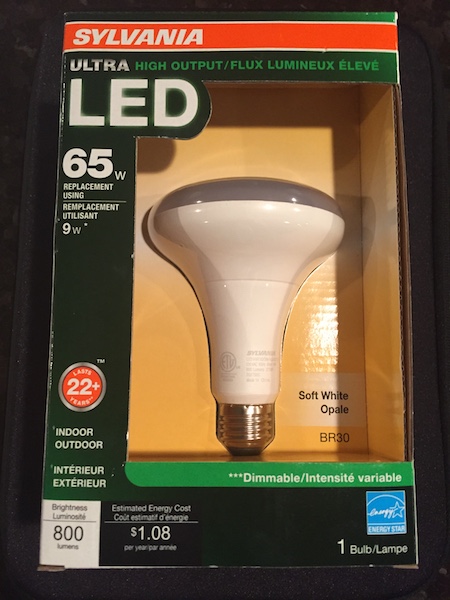posted: June 5, 2017
tl;dr: LED lighting will hopefully not only eliminate incandescents but also fluorescents...
Ever since grade school I have been bothered by fluorescent lighting. My eyes are sensitive to the flicker in an even perfectly working fluorescent bulb, which is flickering (strobing) away at a supposedly too-fast-to-be-detected-by-human-eyes 120Hz. Fluorescents strain my eyes, and may be one of the reasons why I’ve been near-sighted since high school.
Fluorescents have many other shortcomings. The light they produce is usually a pretty stark white, much “colder” than the typical incandescent bulb. They hum. When an incandescent fails you are just left with no light; but when a fluorescent fails you are left with a highly irritating flicker. If you are in a public space the irritation persists until the facilities crew gets around to replacing the replacing the bulb, which may be days later. If you are in charge of the faulty bulb, you have to stop whatever you were doing to eliminate the irritation. Fluorescents don’t work well at low temperatures, such as in an unheated garage: there the MTBF (Mean Time Between Flickering) is much lower. Then there’s the disposal problem with fluorescent bulbs, which contain mercury.
Failed fluorescents are difficult to replace for multiple reasons: there are two bulbs in a standard fixture, and it’s a matter of trial and error to figure out which bulb has gone bad: often the dimmer or more strobe-like bulb is actually the good one. Sometimes the ballast in the fixture itself fails, which you only typically discover after trying multiple replacement bulbs and swapping bulbs with a working fixture. Fluorescent lighting is used because it saves money on energy costs; that money-saving mindset propagates into the design and construction of the fixtures. There is no such thing as a high-quality fluorescent light fixture: they are all made out of barely-thicker-than-aluminum-foil sheet metal and the lowest-grade plastic known to mankind. They break easily, especially the plastic light diffusers. It is very hard to properly position a 4-foot long fluorescent tube bulb into the sockets at both ends simultaneously and then twist to seat the bulb (and I have a longer than normal wingspan); I usually fail on most attempts or am left wondering if the bulb is not working because it’s not properly seated. If you have a room which is entirely lit by fluorescents, there will usually be a single switch controlling all the lights; replacing a bulb in darkness means bringing in temporary lighting or turning on the fluorescents and trying to do the bulb replacement with electricity running through the fixture (the shock is not too bad, in my experience).
The only redeeming attribute of fluorescents, and the reason why they have been so widely deployed in schools and office buildings, is that they are much more efficient than incandescents at converting electrical energy into light. As anyone knows who has touched an incandescent bulb that been on for a while, or used one as the heating element in a kid’s toy oven, incandescents throw off most of their energy not as light but as heat. The quality of incandescent lighting is high (no flicker, warm color), but so is the cost in terms of energy.
What the world needs is a lighting technology with the quality of incandescents and the energy efficiency of fluorescents. CFL bulbs were not the answer because they are just fluorescent lights in a more convenient form factor. The solution may, however, now be here, using a technology sure to please anyone in the semiconductor and computer industries: LED light bulbs.

Incandescent quality at a better-than-fluorescent energy cost
I’ve recently purchased and installed some high quality Sylvania LED light bulbs, and I am impressed. The quality of the light they emit is every bit as good as the incandescents operating right next to them; you can’t tell which bulbs are which. They don’t flicker. They are even more energy efficient than fluorescent bulbs; in fact there are LED bulbs available in fluorescent tube form factors. I don’t yet know what failure modes exist for these LED bulbs: the package says they last for 22 years, so it will be a few decades before I find out, right? I am definitely a convert, and will be replacing my incandescents and fluorescents with high quality LED bulbs over time.
Perhaps someday future generations will look back at our use of fluorescent lights with as much incredulity as we today look back at civilizations who used whale oil for lighting.